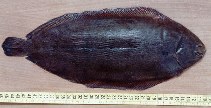| Family: |
Soleidae (Soles) |
| Max. size: |
70 cm SL (male/unsexed); max.weight: 3,000.0 g; max. reported age: 26 years |
| Environment: |
demersal; brackish; marine; depth range 0 - 150 m, oceanodromous |
| Distribution: |
Eastern Atlantic: southward from Trondheim Fjord (including North Sea and western Baltic) and Mediterranean Sea (including Sea of Marmara, Bosporus and southwestern Black Sea) (Ref. 4710). Elsewhere, southward to Senegal (Ref. 4710), including Cape Verde (Ref. 5304). |
| Diagnosis: |
Dorsal spines (total): 0-0; Dorsal soft rays (total): 69-97; Anal spines: 0-0; Anal soft rays: 53-80; Vertebrae: 46-52. This species is distinguished by the following characters: body oval, flat and asymmetric; eyes located on right side of head, except in reversed individuals (Ref. 57416). Upper eye less than its own diameter from dorsal profile of head (Ref. 4710). Anterior nostril on blind side not enlarged (Ref. 4710, 57416), but surrounded by small rim (Ref. 57416). Its distance from front margin of head 1.5-1.9x in its distance from cleft of mouth; anterior nostril on eyed side with backward-pointing tube not or only barely reaching front border of lower eye (Ref. 4710). Preopercle covered by skin and opercle entirely scaled; mouth arched and inferior; dorsal and anal fins lacking spinous rays and united to caudal fin by well-developed membrane, but caudal peduncle distinct; dorsal fin originating on horizontal axis through upper eye; pectoral fin on eyed side asymmetrical, with 7-10 rays, and on blind side slightly shorter; straight part of lateral line visible, supratemporal part slightly arched above eyes; body covered with rectangular ctenoid scales (Ref. 57416).
Description: snout rounded ending in a fleshy lobe; head covered with small villosities (Ref. 57416). Colouration: eyed side more or less dark greyish-brown, with broad and diffuse dark spots; dorsal and anal fins showing same ground colour as body; pectoral fins with blackish spot on distal half; posterior part of caudal fin darker; blind side whitish (Ref. 57416). |
| Biology: |
Adults occur at a temperature range of 8.0-24.0°C (Ref. 4944). Usually solitary. They burrow into sandy and muddy bottoms. Retreat to deeper water during winter (Ref. 9988). Juveniles are found during the first 2 to 3 years in coastal nurseries (bays and nurseries) before migrating to deeper waters (Ref. 92286). Adults feed on worms, mollusks and small crustaceans at night. Waden sea is the most important nursery area. Batch spawner (Ref. 51846). Recruitment is very variable. Frequently found pelagically during spawning migrations (Ref. 35388). Marketed fresh and frozen; utilized steamed, fried, broiled, microwaved and baked (Ref. 9988). |
| IUCN Red List Status: |
Data deficient (DD); Date assessed: 15 July 2014 Ref. (130435)
|
| Threat to humans: |
harmless |
Source and more info: www.fishbase.org. For personal, classroom, and other internal use only. Not for publication.
